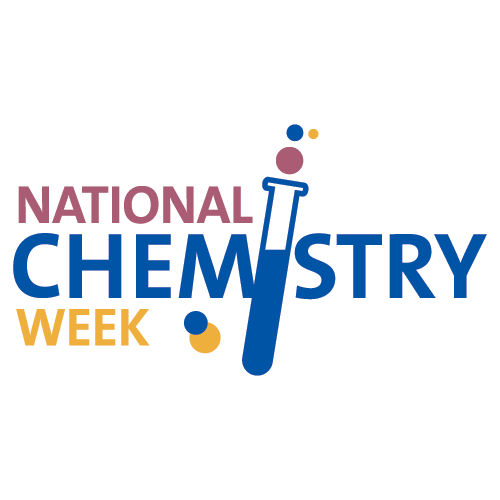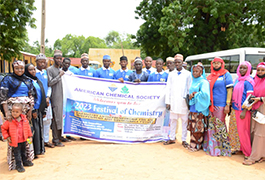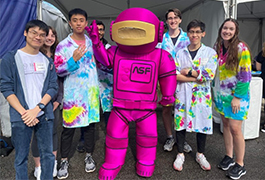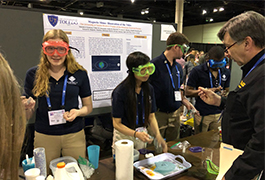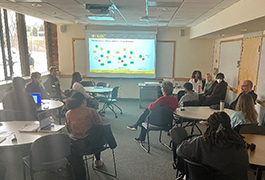Out-of-this-World Demos
This year’s theme for National Chemistry Week (NCW) is space chemistry. And we’ve got some ideas for you to bring outer space into the festivities you’re planning for peers, students, and the community.
When you hear the word “space”, the images that immediately jump to mind are dark regions populated with stars, planets, and galaxies. Or you might think of rockets and space stations. These images can help get your creative juices flowing as you plan activities, and prompt you to ask questions that a lot of people would love to know the answers to: What are stars made of, and how do we know that? If Jupiter is a gaseous planet, how is that different from the solid planet of Mars? If people are going to get to the space station or to Mars, just how are we going to do it? By asking these questions, you can develop some ideas for demonstrations and activities.
Here’s an example: let’s look more closely at the question, “How do we know the composition of stars?” Well, as chemists, we know that orbiting telescopes and spectroscopic techniques are used to analyze the light that reaches Earth. The concept that the composition of a material can be deduced by the emission of electromagnetic waves or its color allows for some pretty visual demonstrations. And you can even provide audience members with a take-home scientific instrument!
Safety first
You’ve probably heard more about safety than you care to think about, but it should be first and foremost in your planning. Your audience isn’t going to care about science if they are more worried about getting hurt. So, build safety into your plans. When choosing your demonstration, you must consider a variety of factors. Don’t just consider flammability; think about toxicity and physical space as well. The Mentos and soda experiment, although nontoxic, is not one that should be performed indoors. Consider, too, what will happen when someone in the audience— without your familiarity with science and safety—decides to repeat your demo at home.
Carefully review the proposed demonstration. You need to know and understand what is happening during the demonstration and what the results are. Will waste be generated that will require special handling? Will there be extreme temperatures, hot or cold? What types of gases may be produced? Will special equipment be required? What types of protective and safety equipment will you need to have on hand? Remember, during any demonstration or hands-on activity, you need to demonstrate proper technique. It is a good idea to check out the Safety Guidelines for Chemical Demonstrations.
Finally, don’t assume that a demonstration is safe just because someone says it is or because people have been doing it for a long time. For example, there have been numerous recent news reports of people getting badly hurt by the “rainbow flame” demonstration, which has been around for decades. There is always the potential for something to go wrong with even the “safest” demonstrations. So do your homework before selecting your demonstrations and activities, get creative thinking about what can go wrong, and figure out how to mitigate any risks. You will then have an exciting and educational show that makes an impression for all the right reasons.
Explaining star stuff
Begin your discussion of space by describing the electromagnetic spectrum and waves. Light is a wave, and the colors of the rainbow are made of light with different wavelengths. This can be demonstrated by creating a rainbow on the wall or a screen with a source of white light and a prism. Of course, the electromagnetic spectrum goes far beyond what you can see; you can demonstrate this by modeling an infrared telescope. And you can go right into a quick demonstration of the Doppler effect and changes in wavelength depending on whether planets or stars are moving away from or toward Earth using a balloon.
Explain that scientists find out what stars are made of by studying their emission spectra. Each element on the periodic table emits a specific set of wavelengths of light. Some of these wavelengths are in the visible range, which you can demonstrate using a safer version of the “rainbow flame” demonstration. Show emission spectra by burning samples of metal salts or aqueous metal salt solutions to show the different colors emitted by the metals. ACS has information about the flame test as well as safety considerations and background materials. Check out ACS ChemClubs for more colorful experiments.
Of course, scientists use more than just their eyes—they also use spectrometers. You can build a webcam spectrophotometer to display spectra from a variety of sources on the screen. Again, with a bit of careful planning, you can show both emission spectra and absorption spectra. To show emission spectra, use a diffraction grating; to show absorption spectra, place different solutions in the path, which will block out various wavelengths depending on the solutions.
Even if you don’t have access to element-specific light tubes, you can display emission spectra by comparing tungsten filaments, compact fluorescent lights, and sodium vapor lamps. For some hands-on or take-home science, have your audience members build their own spectrometer using an old compact disk (CD) and a cereal box or their smart phones, or leave them with the instructions for measuring the speed of light in their home microwave.
Set “phase-ers” to stun
Astrochemistry is not just about the elements but also about their states of matter and thermodynamics. This makes phase change an excellent topic for space chemistry. The concept of phase transitions can be demonstrated using cedar balls, as shown in a video by Dr. Tadashi Tokieda at Stanford University. After an initial explanation of phase changes, there are several demonstrations that can be done using dry ice. When using dry ice, remember to use proper safety techniques to prevent frostbite, and make sure that the area is well ventilated.
If you want to do personalized demonstrations or have something that is hands-on, try boiling water in a syringe to show how pressure affects boiling point. Or you can demonstrate crystallization using Epsom salt paints. To really wow the audience, you might want to finish off by making a batch of liquid nitrogen ice cream.
Dr. Tadashi Tokieda at Standford University demonstrates the concept of phase transitions using cedar balls.
Rocket science 101
Just how does one get into space? And what power sources might be available? Check out a recent ACS Webinar on Rocket Science 101 to help you prepare for your rocket and rocket fuel demonstrations. Have the audience make their own rockets or race balloons to explore how propulsion and rocket design work together.
You can have discussions about the various types of solid fuels (such as 1,3,5-trinitro-1,3,5-triazinane and 1,3,5,7-tetranitro-1,3,5,7-tetrazocane) and liquid fuels (such as liquid hydrogen, liquid oxygen, and highly refined kerosene). Finish with a flourish by putting a rocketry twist on the traditional “elephant’s toothpaste” demonstration using hydrogen peroxide and yeast. This demonstration shows just how much gas you can get from a small amount of liquid.
Finally, solar cells are common on satellites, space probes, and the Mars rovers. Check out the “blackberry solar cell” demonstration outlined in the Green Chemistry Institute’s ACS Student Chapter Guide (p. 7-15). Although this demo requires more preparation time, it will help demonstrate how solar cells work and allows for the discussion of sustainability and renewables.
Last thoughts
The demonstrations and activities highlighted here are supported by ACS resources, making your job just a bit easier. Most of these demonstrations can be performed using readily available materials and have well-documented safety recommendations. But you still have to do some preparation, and you will need to make sure that the demonstrations or activities are appropriate for the audience and location. With preparation and practice, you are sure to provide the “Wow!” for your audience to discover some out-of-this-world chemistry.

